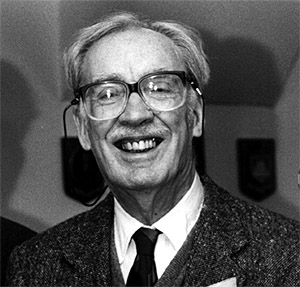The Early Years
1915 - 1939
Gordon Cullingham was born in Beckenham,
Kent on July 10th 1915. In a letter written the day before he
died, he describes for the benefit of his grand-children how
he "could still recall the sounds of the First World War,
when German bombs rained down on SE London".
Apparently, every so often, a Zeppelin (nicknamed "The Baby
Killer") would fly over Croydon dropping bombs as it passed
overhead. Gordon describes how his mother told him that the resulting
explosions were the sounds of trains going over a nearby bridge!
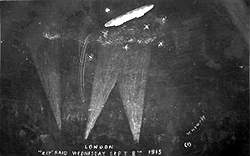 A 'Baby Killer' (Zeppelin) over
London
A 'Baby Killer' (Zeppelin) over
London
when Gordon was 2 months old. (8th September 1915)
In 1924 the family bought their first
car, a Singer 10 with overhead valves - a great advance - but
still only with rear wheel brakes. Gordon writes "This 4-seater
Open Tourer took us - just about - to the Sussex coast and Suffolk
and to Buckinghamshire where my father must have had connections."
The family home was probably typical of the time,
gas lighting down stairs, candles in the bedrooms and a kitchen
range that provided, "more or less, heated hot water, but
the bathroom was not often used. A galvanised bath served in
front of the kitchen range fire, with its steel parts that had
to be brightened by emery rubbing, the black being black-leaded.
Our steel knives had to be cleaned until they shone on an emery
board, a chore that my elder brother disliked."
"The milkman came round with a handcart and
brought a churn daily to the back door where a jug would be filled
with a pint (or two) of fresh milk - which in summer often went
sour. There were no fridges. The baker called with his horse
and cart, which reminds me that the horses were the source of
much energy, and must have been fed from acres of fields of grass
and corn, later to be replaced by steam Foden wagons and petrol
engined lorries and cars."
In 1927 Gordon moved to a nearby house in Beckenham
which had electric light and a garage for their next car, an
Austin 12 Tourer.
Gordon lost some time at school due to illness but
studied hard in his teenage years in the early 1930s to gain
his qualifications for the Institute of Chartered Surveyors (ARICS).
By this time the family had moved to Herne Bay, Kent, where Mr
Cullingham senior built a new family house in Queensbridge Drive
at the junction with West Hill Road.
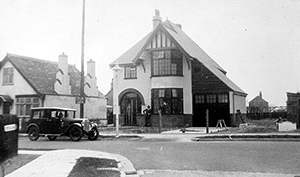
'Ambleside', Queensbridge Drive,
Herne Bay built in the summer of 1931, seen here on completion
in November of that year.
In 1931 his father bought a new Austin
12 saloon, a car that Gordon was later to use around Windsor
until 1956, and with which they towed a magnificent caravan,
'Curlew', which weighed almost a ton and a quarter! Not surprising
- it even had leaded windows!
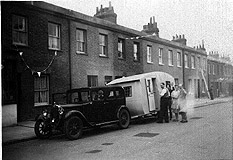 Bexley Street, Windsor, at the
time of the Coronation in 1953,
Bexley Street, Windsor, at the
time of the Coronation in 1953,
and the Cullinghams have a newly fitted out pre-war caravan
ready to depart for their holidays at Selsey Bill.
The caravan has leaded windows, I promise!
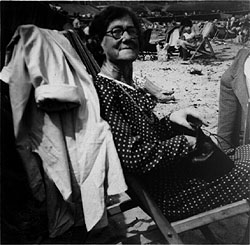 Gordon's mother, Lilian Margretta
Gordon, at Herne Bay in the 1930s
Gordon's mother, Lilian Margretta
Gordon, at Herne Bay in the 1930s
Gordon's first employment was in Colchester
in the Town Planning Office, the journey from Herne Bay being
made in, as Gordon describes, "a decrepit Morgan 3 wheeler"
which included a river crossing at the Woolwich Ferry. He would
make this journey regularly, travelling from his 'digs' to his
parents' home back in Herne Bay.
Soon after he worked in the Borough Engineer's office
in Canterbury and met his wife-to-be, Mollie. Only later were
they to discover that they had been born in the same road, Mackenzie
Road, Beckenham! In the run-up to WWII Gordon worked at Bexhill.
Gordon recalls that he remembers seeing the fire
that destroyed the Crystal Palace near Croydon on 30 November,
1936. He drove over to witness this major loss to the London
skyline. Although the Crystal Palace was not quite the size it
had been when originally erected in Hyde Park for the Great Exhibition
of 1851, Gordon would have been very interested in the building,
both from a historical and an engineer's point of view.
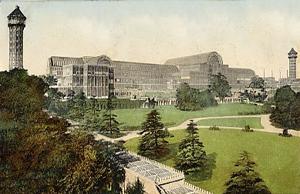 The Crystal Palace, reconstructed
in South London
The Crystal Palace, reconstructed
in South London
The Windsor Years
1939 - 1999
Gordon came to Windsor in May 1939 as
Assistant Engineer to work in the large drawing office at the
Windsor Corporation 'depot' in Alma Road, no. 16, since demolished
to make way for Ward Royal in the late 1960s. With the outbreak
of war with Germany in September 1939 some territorials had been
called up and the rest "registered" at intervals. Gordon
was at first "reserved" but he was never called up,
possibly because of the nature of his work in the borough.
In 1941 Gordon and Mollie married and towards the
end of that year their first son, Mark, (1941-1995) was born.
Graham Mark Cullingham web page.
Meanwhile F.N. McRae, the Borough Engineer, was becoming
ill from asthma. He was in charge of the Rescue and Decontamination
parties, but had done no training, and the gear was still in
the store room. Gordon had done some training at Bexhill and
found that he had to take over. There were three Rescue parties
and three Decontamination parties, all from Borough workmen.
The County ARP was at Steventon, and Gordon recalls a rare opportunity
to drive a Ford ambulance full of men being taken for advanced
training. This was the first chance to drive for months - his
father's old Austin 12 was laid up for the duration of the War,
with virtually no petrol available. Gordon describes how driving
at 70 mph was great fun!
Then came the Baedecker air raids and Gordon's call up to the
Royal Engineers but Mr McRae was ill and somehow Gordon was deferred
"for three days or until a substitute was found". He
kept his kit bag under the stairs beside where his wife Mollie
used to shelter their baby son, Mark, in case of air raids. This
was at "Nancledra," 6 Maidenhead Road, opposite the
newly built Grammar School. Gordon and Mollie had set up home
at No. 6 in April 1941 and were to live there until 1948 and
the move into their own, newly built home, 112, Clarence Road.
Throughout this period, Gordon's deferred call-up
to the Royal Engineers was never cancelled and lasted after the
war, until the call -up ended. Most of the borough staff had
in fact been called up. Eventually Gordon had to work a double
shift on housing plans and other planning matters, sometimes
until midnight. But he was still holding his rail pass to the
Royal Engineers.
In 1945 Mr McRae died and Gordon was appointed to
take over but this was not to endure, despite his significant
qualifications, because when the Labour Party took over from
the Conservatives one of their objectives was to have a qualified
architect in charge of housing, resulting in the appointment
of G.S. Baker. But he was not an architect, so it was a shock
to Gordon as his housing plans had been approved by the Ministry
and he was eminently qualified and capable.
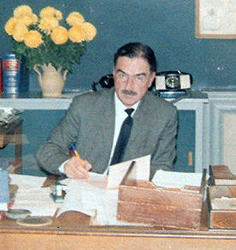 Borough Engineer, Geoffrey Baker,
November 1964
Borough Engineer, Geoffrey Baker,
November 1964
Gordon recalls that an alderman was critical
of his plans because the "C" type houses faced in different
directions. Gordon describes in his letter how "...my Doctor
had given me a pill to take "in case of need". I took
the pill at the Council meeting and this resulted in my being
"in top gear" and "dealing with every quibble!!"
There is no doubt that Gordon was highly qualified - he had continued
to acquire additional qualifications throughout this period -
but there were those who perhaps considered him too young, despite
his experience in the Borough, or were less convinced than others
by the value of qualifications. Gordon writes "It was experience
rather than my qualifications that I could rely upon, but the
latter was invaluable to those who doubted the value of qualifications.
"Would you like to be operated upon by an unqualified surgeon?"
flattened the doubters!
In 1947 Gordon was closely involved with the Windsor
Flood in March of that year. Mollie Cullingham describes how
she went out into Maidenhead Road to see the flood waters creeping
up from the west. Although the water reached their front door
at No. 6, Maidenhead Road, the water remained just under the
floor boards. Nevertheless, they were required to share the upstairs
flat with another family for the duration of the flood. Gordon's
history of the flood is available at The
Floods of Windsor, 1947.
In 1948 Gordon and Mollie built their own house,
112, Clarence Road, in conjunction with Mr Lilley, a director
of Miller, Morris and Brooker, the builders' supplies company
in Slough. A beautiful Silver Birch sapling was planted in the
front garden, lifted from Windsor Great Park by Gordon's 7 year
old son Mark at the time the house was built. Sadly the silver
birch was cut down in 2006.
Gordon described to his grandchildren how, while
taking a weekend break with his wife Mollie and his family in
Herne Bay in early 1948, he heard on the radio how building permissions
were to be tightened up and that any applications received after
Monday would not be granted. Gordon realised that plans for his
new house would be scuppered if he did not get the relevant papers
to the right department at Reading, Berkshire, in time for first
thing Monday morning. He therefore jumped into the family Austin
12 and drove from Herne Bay to Windsor, grabbed his and several
other people's applications from his desk and raced to Reading
to beat the deadline. A day or two later he received a call from
the officer in charge in Reading. "It's funny," the
officer said, "I could have sworn that I had completed all
outstanding applications on Friday night!!!"
Fortunately Gordon's papers were passed and he received
the necessary permits for the purchase of timber, etc. required
for his house to be completed soon after the birth of their second
son, Roger.
In 1949 The Borough Offices were relocated to Kipling Building in Alma Road. Originally
built for the Imperial
Services College in 1939, the school moved away at the start
of the war and the War Dept took over the premises, subsequently
releasing them to Windsor Corporation in 1949. It is here that
Gordon worked as Deputy and subsequently as Borough Engineer
until the merger with Maidenhead in 1974. Kipling Building was
demolished in 1981 to make way for the Rank Hovis McDougall office
development, later occupied by Reckitt and Coleman and then by
the The Six Continents Group. Gordon and Mollie moved from Clarence
Road to a turn of the century house in Alma Road, directly across
the road from Kipling Building, in 1967.
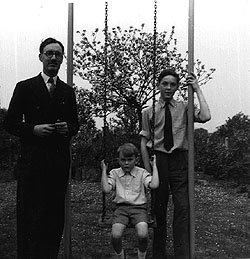 Gordon with his two sons at his
home in Clarence Road, 1954
Gordon with his two sons at his
home in Clarence Road, 1954
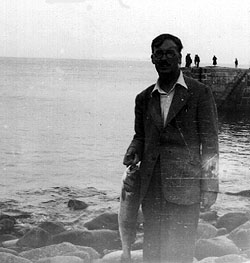 A proud fisherman with bass -
Lamorna Cove, Summer 1956
A proud fisherman with bass -
Lamorna Cove, Summer 1956
Gordon was the 'Responsible Officer' for a considerable variety
of projects in the Borough throughout the 50s, 60s and 70s, notably
the Civic Trust
Face Lift of 1961. The were numerous other events, some of
them with Royal connections, with which Gordon was involved and
which we will be featuring on this Web Site as the stories are
completed and illustrated.
Gordon was appointed Borough Engineer in 1966, a
position he held until RBNW merged with Maidenhead in March 1974
and he could then retire to a life of local history research,
family genealogy and taking up the cudgels when the need arose
for a local campaign or five! It is probably this aspect that
most Windsorians will remember him for.
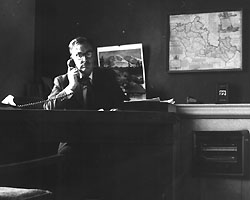 Gordon Cullingham at his desk
in Kipling Building
Gordon Cullingham at his desk
in Kipling Building
Details of Gordon Cullingham's various campaigns are included
on ThamesWeb. There are reference areas for the 1989
Vansittart Road Open Space and we shall be covering the attempt
to turn The Bachelors Acre Burial Ground, now a peaceful area
to the north of the Acre, into a Car Park for The Castle Hotel,
a scheme that the Friends of The Old Burial Ground successfully
scuppered after taking their battle as high as Privy Council.
There was also the shadow cast over the houses in Alma Road,
one of which was the birthplace of both Sir Sydney Camm, the
designer of the Hurricane fighter, and Fred
Camm, Editor of the 'Practical' series of magazines. [Alma Road Car Park Campaign.]
We have also included a history of The
Great Freeze of 1963, the story of which Gordon had made
a start on in the months before he died, and The
Royal Windsor Tapestry Works which was one of his earliest
projects, completed in 1979, and published originally by The
Royal Borough of Windsor and Maidenhead. Gordon also wrote a
book about Patrick Y Alexander, pioneer aviator for Cross Engineering
of Bath, and a biography of Fred
Camm, the Practical Magazine editor.
Gordon, in his final year, and not nearly as strong
as he would have liked, continued to campaign vigorously from
a background of knowledge and experience that it will be impossible
to replace.
In the passing of Gordon Cullingham, Windsor is much
the poorer. The love of his family, the respect and admiration
of his friends and colleagues, and the grateful thanks of many
thousands of Windsorians past, present and, I have no doubt,
in the future, goes with him.
With the kind agreement of his wife, Mollie, the
ThamesWeb
Windsor History Zone is respectfully dedicated to his memory.
Cullingham Genealogy:
In his later years Gordon spent much time researching his family
history. Enquiries from other Cullinghams would be welcomed,
although his research has yet to be thoroughly organised and
annotated.

To contact us, email
Thamesweb.
|


